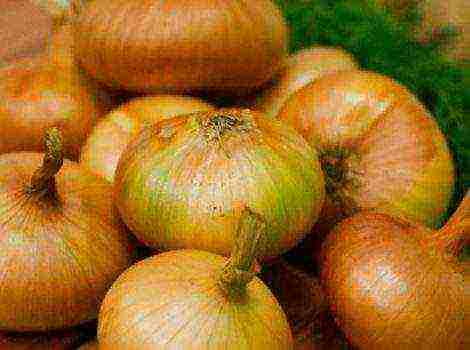Content
- 1 Varieties of irises
- 2 Bearded irises
- 3 Dwarf irises
- 4 Bulbous irises
- 5 Siberian irises
- 6 Swamp irises
- 7 Japanese irises
- 8 Medium, tall and miniature bearded irises
- 9 Requirements for tall bearded irises
- 10 Agricultural technology for growing bearded irises: planting and care
- 11 New varieties of tall bearded irises for the middle lane
Entering the village garden on a warm June day, you will surely see an overgrown curtain of elegant cockerels. Simple and unpretentious, but no less charming. The folk flower also has a more euphonious name - iris; there is both a rich pedigree and its own elite. The magnificent varieties of irises with photos and names described in this article will appeal to amateur flower growers and professional garden designers.
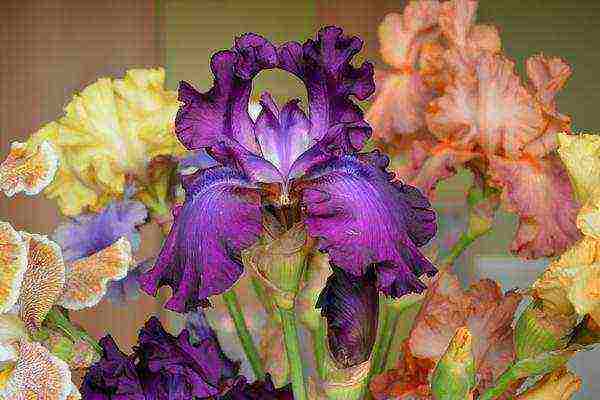 Iris - the personification of grace and grace
Iris - the personification of grace and grace
The rhizome perennial belongs to the Kasatikov family and has almost 800 species, which are distributed almost all over the planet. It is difficult to find a person who does not know what an iris looks like - his flower is so unusual that once you see it, you will not forget. But if there are any, we offer a description of the plant.
His rhizome is creeping, divided into annual links. A fan of flat xiphoid leaves sprout from each segment in spring. A thick, strong peduncle emerges from this bunch, on which from 1 to 6 single flowers bloom.
The flower itself is large - 7.5–11 cm high, up to 18 cm in diameter, consists of 6 petals (lobes) - three inner and three outer. The inner petals are usually raised upward and form a "crown" or "goblet". The outer lobes, also called fouls, diverge horizontally or downward.
Both the variegated color of the petals and the palette of numerous varieties of irises confirm the name of the flower, which is translated from Greek as "rainbow". There are a variety of tones and combinations:
- monochromatic (self) - white, pastel, rich, almost black;
- combinations with traditional color combinations - white with blue, yellow with brown;
- contrasting combinations of tones and shades, for example, pink with lavender;
- variegated (speckled, bordered).
There is no single international classification of the plant - in our country only rhizome perennials are called irises; in Europe, the bulbous relatives of the flower are also included in the same genus. And the domestic garden classification for a simple amateur gardener does not add clarity. If you do not delve into botanical details, the following types of irises are most often grown in gardens and parks:
- bearded (the most numerous, widespread and demanded group);
- Siberian;
- Japanese;
- Spuria irises;
- bulbous hybrids (Dutch or English).
Before purchasing collectible irises, carefully familiarize yourself with the assortment and resistance of the item you like to the climatic conditions of your region. Many of the hybrids bred in the USA, Japan, Holland, Australia are thermophilic and cannot withstand the frosts of the middle zone, not to mention Siberia or the Urals.
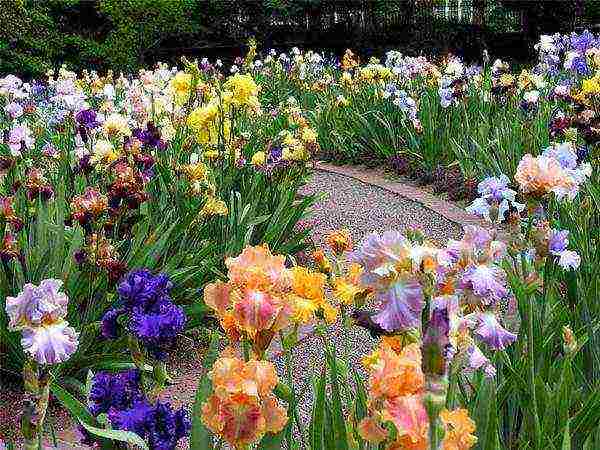 Having picked up varieties with different flowering periods, you will enjoy a rainbow palette from mid-May to July.
Having picked up varieties with different flowering periods, you will enjoy a rainbow palette from mid-May to July.
More than 500 varieties and interspecific hybrids - bearded iris can boast of such a large family.
A powerful, viable and unpretentious perennial according to the height of the bush is divided into 3 groups:
- dwarf varieties (21–40 cm);
- medium-sized (41–70 cm);
- tall (from 71 cm).
In the tall group, forms are bred that grow up to 110–120 cm with powerful peduncles, which simultaneously bear 5–12 flowers. The higher the plant, the larger and more massive they are, with dense, corrugated petals, a "lace" edge.
A distinctive feature due to which the iris received its specific name is the so-called beard, clearly visible in the photo below. It is a shaggy strip of dense, short hairs located at the base of the central vein of external fouls. In color, it can either coincide with the main background, or contrast with it.
 A coral-colored beard is clearly visible at the base of the outer petals.
A coral-colored beard is clearly visible at the base of the outer petals.
Advantages of the species
It is no coincidence that bearded irises are so popular. In addition to the magnificent appearance and the vast palette of colors and shades, they have a lot of other advantages.
- The plant grows rapidly and intensively.
- It blooms profusely and for a long time.
- A large number of frost-resistant varieties have been bred that do not need to be covered for the winter.
- The flower is hardy, rarely sick, resistant to pests.
Bearded irises are good in the flowerbed and in the cut. Dwarf varieties are appropriate in curbs and on alpine slides, solo and in composition with other perennials. Tall specimens are indispensable for tapeworms, look great in a company with lilies and peonies.
Review of popular varieties
We offer a small selection of varieties of bearded irises with photos and names. This is only a small part of the assortment offered by domestic and foreign breeders, for which we have chosen spectacular specimens that have positively proven themselves in our conditions.
- Supreme Sultan is a two-color hybrid of American selection, a powerful plant more than a meter high. The inner petals (standards) of a rich yellow-ocher color, gathered in a crown, fouls are cherry-burgundy with a yellow beard, lowered low. The edge of the petals is corrugated. The flowering period is May-June.
 In the photo - American variety Supreme Sultan
In the photo - American variety Supreme Sultan - Thornbird is a popular variety of green-flowered "bearded", tall (over 80 cm) with a strong peduncle and a luxurious fan of leaves. The flower is large (ø 13–14 cm), orchid-shaped with cream standards and greenish-mustard fouls, on which a yellow beard with a purple-brown horn stands out. Blooms in June-July, luxuriantly and abundantly. Suitable for growing in the middle lane.
 Green-flowered variety Thornbird
Green-flowered variety Thornbird - Sultan Palace belongs to the spectacular monochromatic hybrids of the Dutch selection. The height of the bush is about a meter, the flower is large with a diameter of up to 15 cm. The upper and lower petals are dense, velvety, rich reddish-brown color with burgundy veins along the field and a slightly corrugated edge, the beard is yellow. The flower smells good. The plant belongs to the highly winter-resistant group, will delight with long and lush flowering.
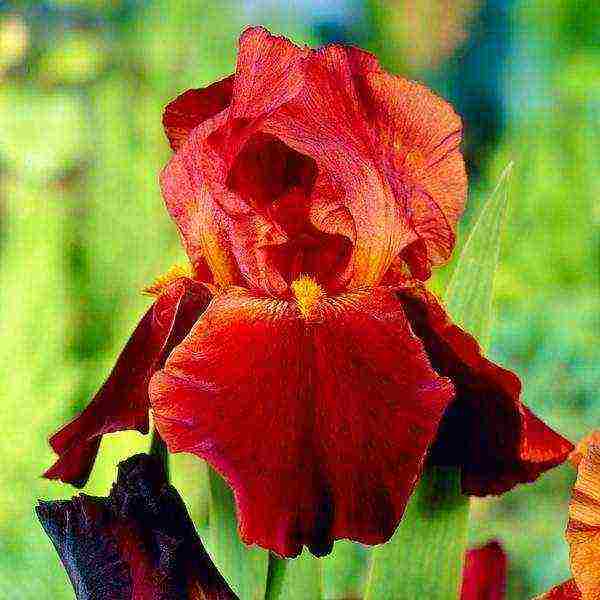 Red - one of the most elegant irises
Red - one of the most elegant irises - Vibrant is a variety of irises for those who love yellow flowers, so gorgeous both in the flowerbed and in the photo. The color is solid, dense, golden yellow, the petals are strongly corrugated along the edge, yellow-orange beards are barely noticeable at the base of the fouls. The flower has a light, exquisite aroma. The plant itself is of excellent quality, high (from 85 cm), large-flowered, does not degenerate during the growing season. Blooms early.
 A flower for lovers of sunny irises
A flower for lovers of sunny irises - Vizier is a magnificent tall variety with large, solid colors. A rich palette of petals plays with raspberry-purple, cranberry, pomegranate shades. Ruffled petals with “bubbles” along the edge. On bright fouls, an orange goatee stands out.
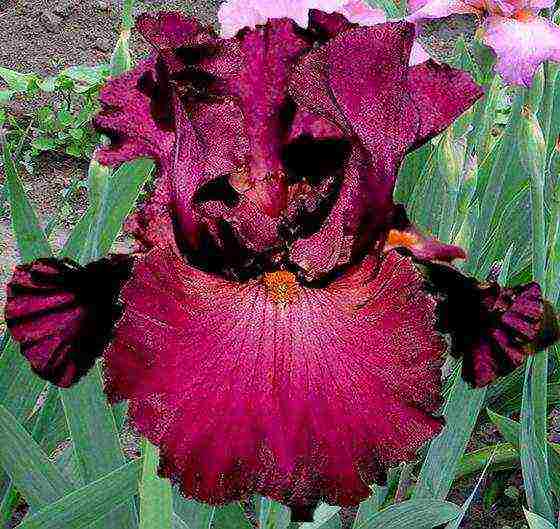 In the photo - a variety of irises Vizir
In the photo - a variety of irises Vizir - Champagne Waltz is a tall, two-tone hybrid of an American originator. Standards of a delicate peach shade with apricot veins, fouls are white with an apricot yellow border, low dropped. The petals are dense, corrugated, with a velvet texture. The beard is red-orange.
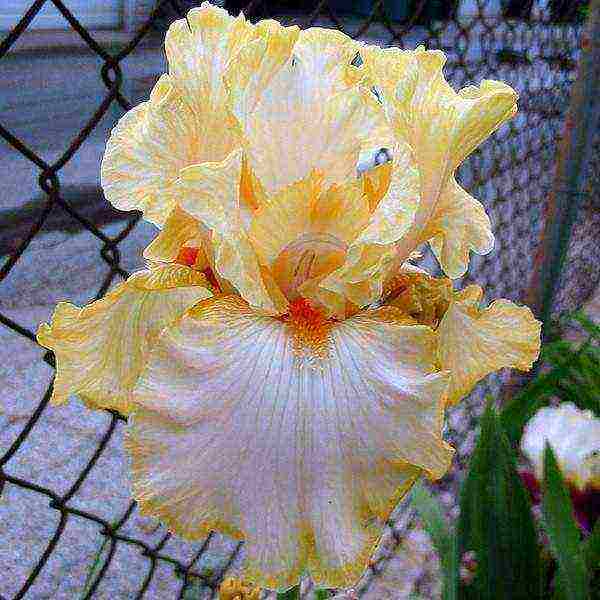 Border on the edge of fouls - a new trend in the selection of irises, the Champagne waltz variety
Border on the edge of fouls - a new trend in the selection of irises, the Champagne waltz variety - Immorality is the amazing white iris pictured below. Standards, fouls, beard - everything in this flower is pure snow-white, the petals are slightly wavy, with a velvet texture. The height in the peduncle is 75–85 cm. The uniqueness of the variety is its remontability.The first time it blooms in May, again, in favorable weather conditions - in September. Differs in good frost resistance.
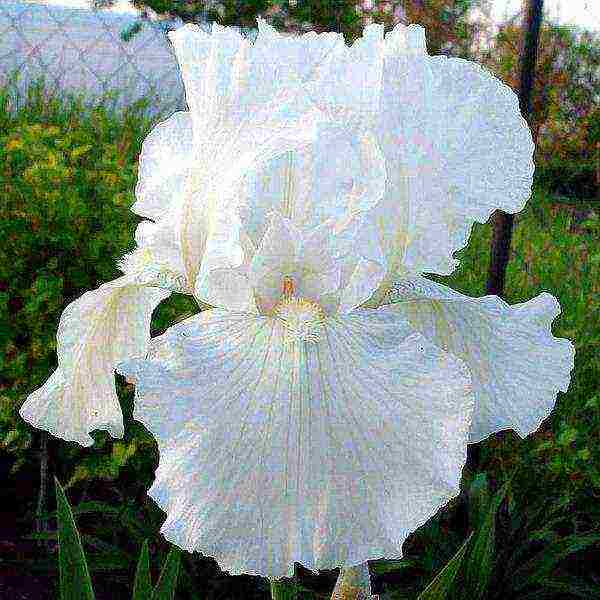 The re-blooming iris of the Immorality variety
The re-blooming iris of the Immorality variety - Toronto is a tall mid-early hybrid of an American originator. The flowers are large (ø 13–16 cm), two-colored, hovering in shape. The inner petals are of a warm pinkish-peach color with a wavy edge, the fouls are of a contrasting maroon tone, passing along the edge into a burgundy-pink "lace" frill. The dark foul has a distinct red-orange beard. A very colorful, elegant flower!
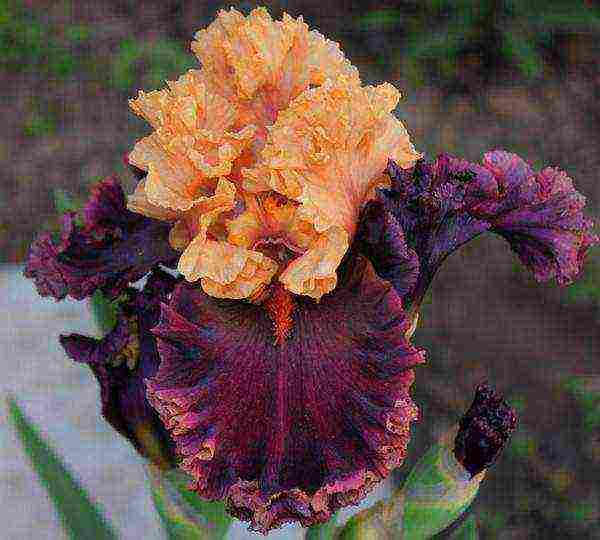 In the photo - Toronto iris
In the photo - Toronto iris - Super Model is a tall, monochromatic handsome man with large lavender flowers. The shape of the flower is orchid-like with soaring fouls, the petals are corrugated, with a fringed edge, decorated with an orange beard with white tips. Iris of this variety smells good. Blooms in July, hardy.
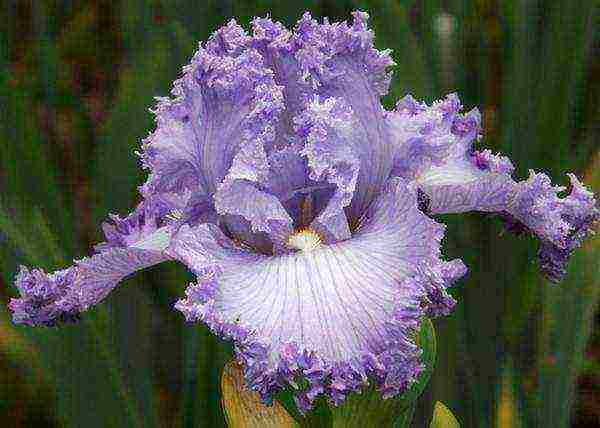 Smart variety is a real Supermodel
Smart variety is a real Supermodel - Super Hirow is a real superhero with a cap of large, heavy flowers on a strong, high peduncle. The crown is formed by white standards with a golden border, the fouls are horizontally located, with an ocher area in the center, turning into maroon, almost black edges. A bright spot on the petal stands out with a golden yellow beard.
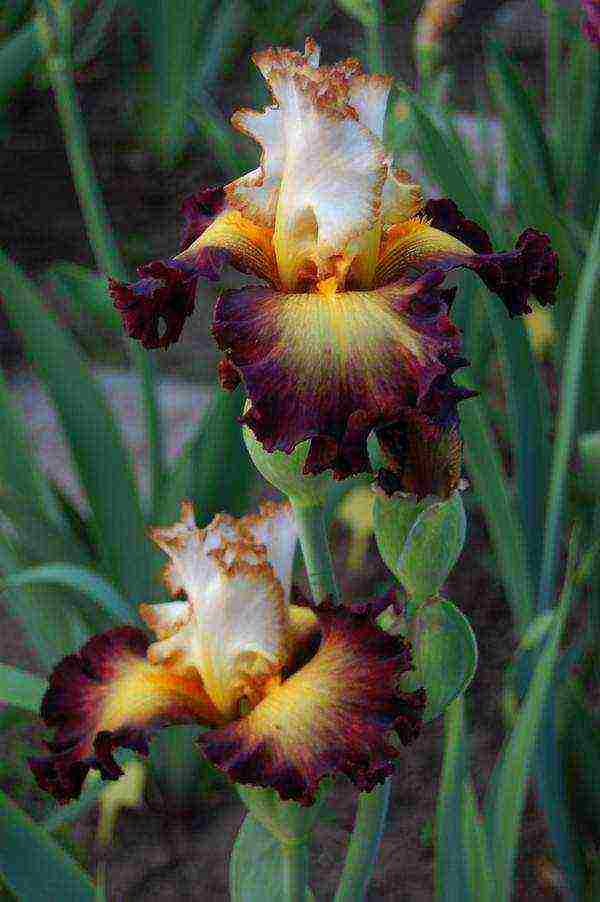 Bicolor Superhero Variety
Bicolor Superhero Variety
Siberian irises
Our compatriot Siberian iris in the photo looks like a bearded relative, but in the structure, agricultural technology and description of the flower it has a number of differences.
- The shape of the flower is similar, but it is somewhat smaller, without a beard, the petals are narrower and elongated. Although in fairness it must be said that some modern varieties in flower size can compete with irises beards.
- The plant grows into large bushes and simply expels a huge number of flower stalks.
- The foliage of this species is brighter and more elegant, serves as a decoration for the garden even after flowering.
- The species is extremely hardy, cold-resistant, more reliable in adverse weather conditions.
- Unlike the bearded iris, this flower can grow and bloom in the shade.
Unfortunately, Siberian irises do not smell. But this does not detract from the decorative possibilities of the flower and the interest in it on the part of breeders.
Assortment of Siberian irises
Dozens of varieties and hybrids of Siberian irises for every taste have been bred in the world, we have collected some of them in this collection with photos and names.
- The Snow Queen is a tall "Siberian" with bright green foliage and an incredibly graceful medium-sized flower (ø 10 cm). The petals are snow-white, in the places where the fouls bend - with a bright yellow back. Blooms in July. In especially cold winters, in order to avoid freezing of generative buds, it is better to cover.
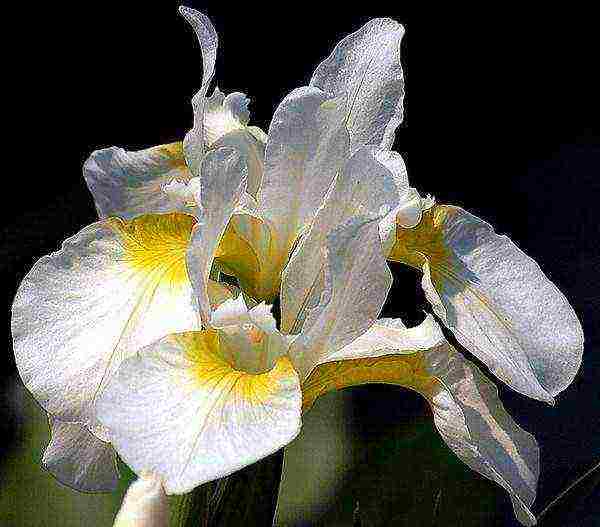 In the photo, Siberian iris Snow Queen
In the photo, Siberian iris Snow Queen - Cambridge is a time-tested, reliable and highly decorative variety. The height of the bush is 80–100 cm. The flower is medium-sized, graceful, with soaring azure-blue petals and a yellow base. It grows quickly, blooms profusely. The variety is resistant to severe frosts.
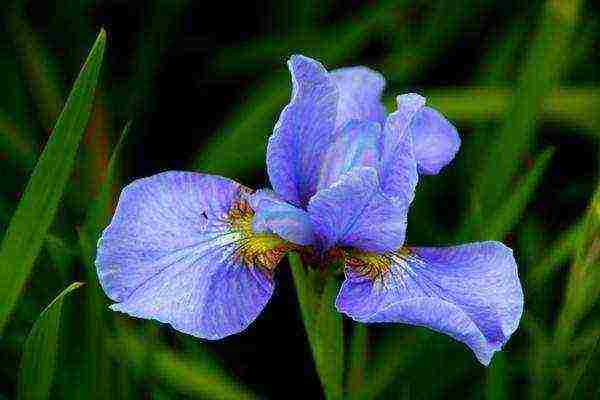 Sky blue iris cambridge
Sky blue iris cambridge - Impression is a medium-sized representative of Siberian irises with half-meter peduncles. The flower plays with a mixture of violet-red and amethyst color with tiger strokes at the base of the lower petals, the styles are almost white.
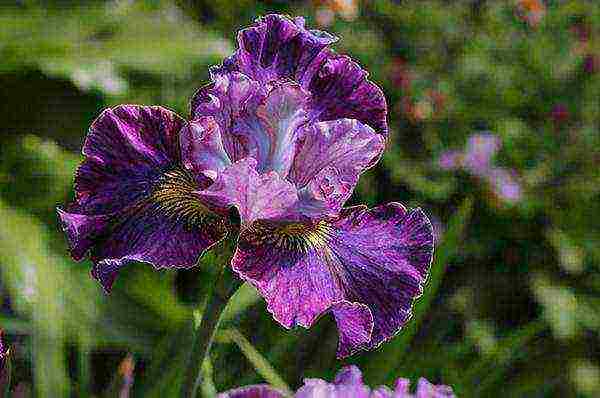 Amethyst Iris Impression
Amethyst Iris Impression - Magnum Bordeaux is an impressive hybrid with a very large floating flower on a 70 cm stem. The petals are slightly corrugated, with a velvety texture, very elegant. The deep purple color is complemented by blue-yellow spots at the base of the fouls and purple streaks.
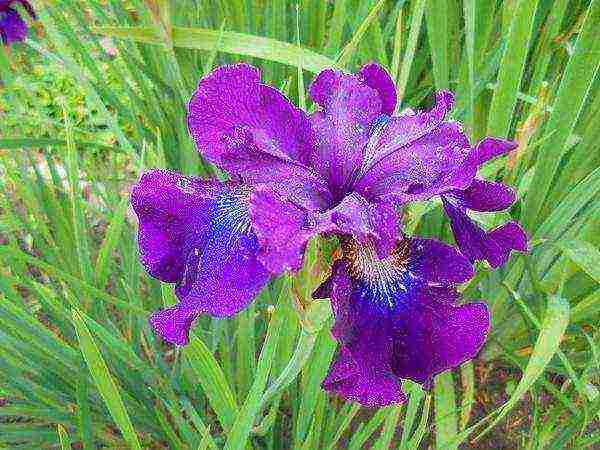 One of the brightest representatives of the species
One of the brightest representatives of the species - Double Standard is a representative of the collection of Siberian terry irises. The flower is blue with a lavender tint, there is a contrasting yellow spot on the fouls. The petals are velvety, dense, slightly corrugated. Blooms in June. The variety is recommended by leading growers as unpretentious, frost-resistant, intensively growing.
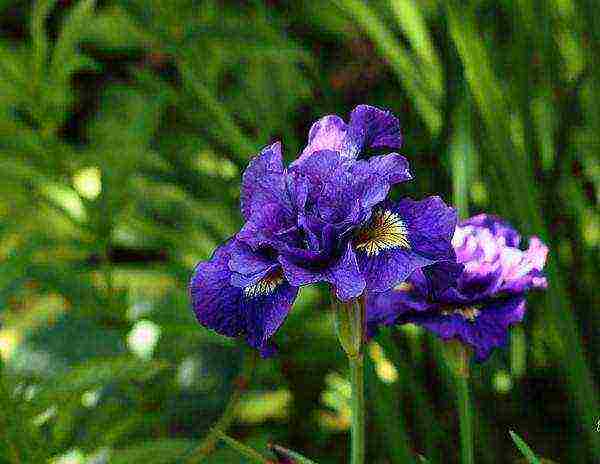 Terry petals give the flower a resemblance to Japanese irises
Terry petals give the flower a resemblance to Japanese irises - Jinje Twist is a tall, early, abundantly flowering Siberian. The flower is two-colored - the upper lobes are light fawn with lavender spots, the fouls are ocher-yellow, turning into a mustard edge, with brown veins and small splashes of lavender. One of the few smelling varieties of Siberian irises.
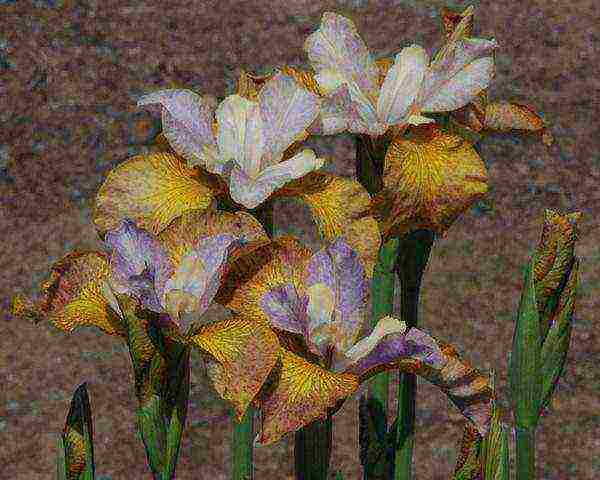 Each Jinje Twist flower stalk carries 5-7 buds
Each Jinje Twist flower stalk carries 5-7 buds
Japanese irises
The xiphoid irises that grow in Japan and in our Far East are called Japanese. This is not a specific, but rather a collective term. For a long time they were considered unsuitable for cultivation in the northern regions, they were grown in Primorye, in the Caucasus, the Black Sea coast. Breeders are trying to actively promote the culture to the north, more or less frost-resistant varieties have appeared, but in general, the "Japanese" in the middle zone do not have enough heat and light.
The flower of the Japanese iris is very interesting - large (ø up to 25 cm), similar to a saucer. All 6 lobes are bent horizontally, only branches of pistils (styles) with an openwork comb at the end are raised upward. In addition to monochromatic and two-color varieties, common varieties are speckled, bordered, with contrasting colored veins. Let's give an example of several of them.
- Vasily Alferov is one of the first winter-hardy cultivars of domestic selection. Standards are white, fouls with blue-orange specks. The crisp white styles are finished with a fringed comb. On the arrow-shaped peduncle there are 3-4 flowers up to 20 cm in diameter.
- Kogesho is a xiphoid hybrid of Dutch selection, tall (80–120 cm). Leaves are light green with a central purple vein. The flower consists of a double row of lilac-white petals with a yellow spot at the base, styles are white with a coquettish comb. The variety hibernates under cover.
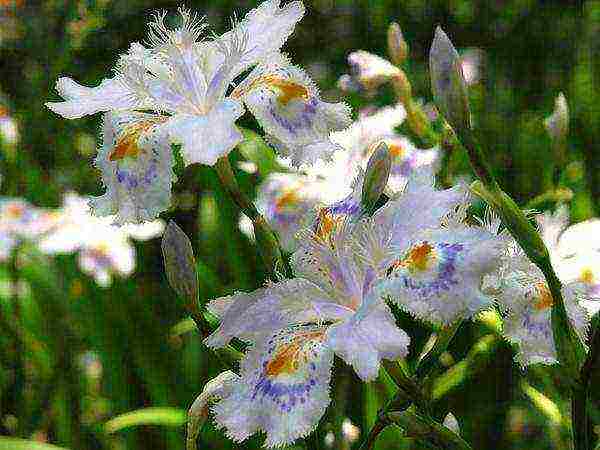 In the photo - the popular Kogesho variety
In the photo - the popular Kogesho variety - Lyon King is a magnificent hybrid with a very large flower. Consists of 9 lobes, gathered in a fluffy layering "skirt". Petals with snow-white centers and purple-pink corrugated edges, yellow smear is visible at the base of the central vein, styles are white. The variety is thermophilic.
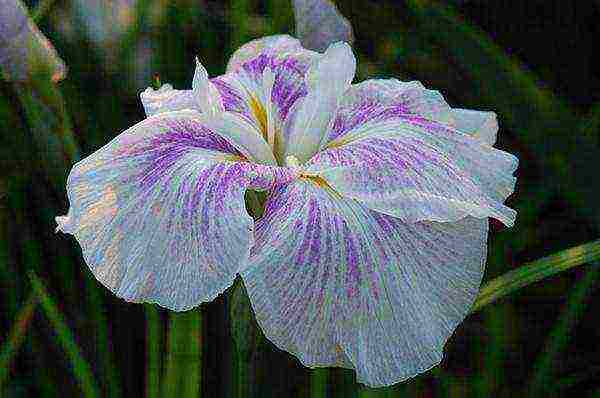 In the photo - the variety King Lion
In the photo - the variety King Lion - Crystal Helo is a frost-hardy plant with strong growth and lush flowering. The upper and lower petals are slightly corrugated along the edge, lowered down. The main field and styles are lavender-blue with purple veins, bright yellow strokes along the central vein of fouls.
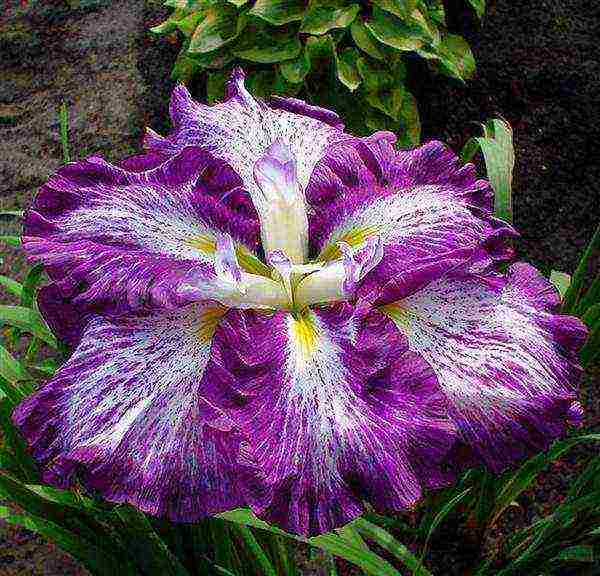 Purple yellow japanese iris
Purple yellow japanese iris - Freckled Geisha is a terry hybrid with nine lobes. Petals are snow-white with lilac-lilac specks and the same border, corrugated along the edge. The branches of the pistils are white with a lilac comb. Plant height - up to 85 cm.
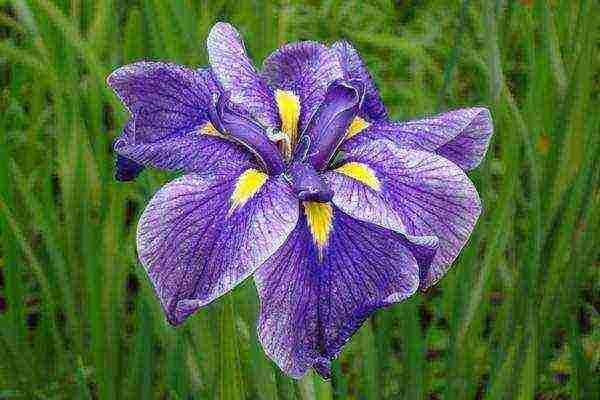 Lilac and white iris Freckled Geisha
Lilac and white iris Freckled Geisha
Bulbous relatives of irises
Bulbous xyphyums are flowers very similar to irises. In the English, Dutch tradition, they are called so - bulbous irises.
The main difference is the presence of bulbs instead of rhizomes. Their leaves are narrower, grooved, rather like a daylily, the peduncles are thin and tall. The flowers are identical in structure to cockerels - they consist of 6 lobes, some species on fouls have a marigold bent upward, as can be seen in the photo below.
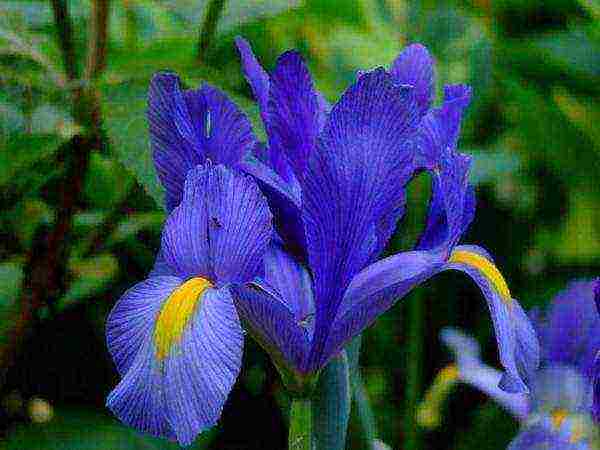 It looks like a bulbous iris
It looks like a bulbous iris
In the southern regions, this flower is cultivated quite successfully, but in the north it does not take root, and even if it blooms in some years, then it withers and disappears.
Another flower, reminiscent of either irises or daylily, is the now fashionable alstroemeria.
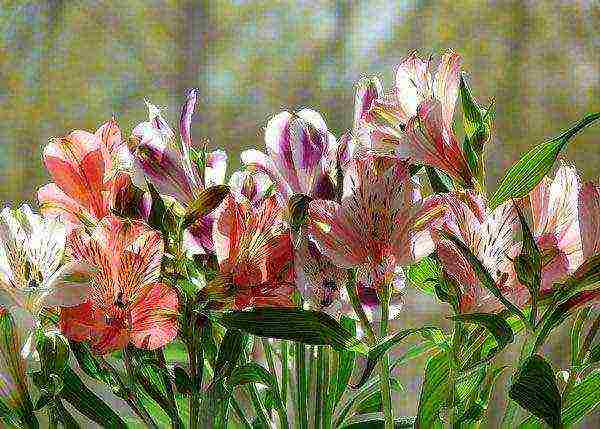 In the photo - alstroemeria
In the photo - alstroemeria
It is a South American rhizome perennial growing up to 1 m. Flowers - six-petalled, variegated, multicolored. The plant is thermophilic, so it can be grown in the garden only in the south, in the middle lane - only in greenhouses.
Videos about the types and popular varieties of irises:
Moscow, Russia, on the site since 11.01.2017
Have you read it? Don't forget to rate
(
estimates, average:
out of 5)
Main page ›Forums› Flower garden and landscape ›Ornamental plants and their care› Interesting varieties of bearded irises
This thread has 34 replies, 4 members, last updated Maxim Savinov 2 weeks, 3 days back.
Viewing 10 posts - 1 through 10 (of 35 total)
-
author
Messages
-
In this thread, I propose to lay out interesting varieties of bearded irises. It can be not only new, but proven and loved ones. The basic rule is that you need an accurate title and a good quality photo.
Bearded iris "Champagne with strawberries"
Tall Bearded Iris 'Champagne and Strawberries'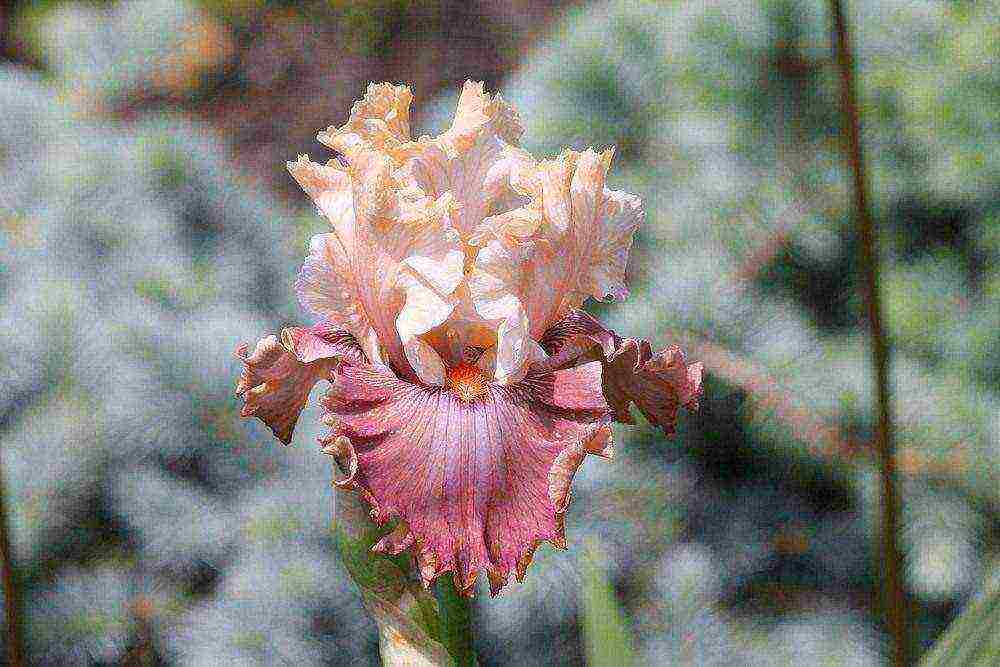
Selection: Barry Blyth.
The year of registration and introduction is 2007.Investments:
Viewing 10 posts - 1 through 10 (of 35 total)
You must be logged in to reply to this topic.
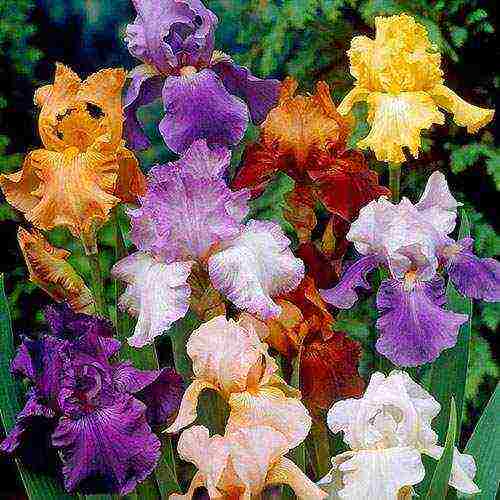 Irises have long gained popularity due to their unusual appearance and unpretentiousness. They are practically maintenance-free; even an inexperienced gardener can cope with the cultivation. A lot of varieties of this plant have been bred. In order not to get confused in such a variety, it is necessary to study irises, varieties with photos and names in advance. This will help create a spectacular garden that will be the envy of all neighbors.
Irises have long gained popularity due to their unusual appearance and unpretentiousness. They are practically maintenance-free; even an inexperienced gardener can cope with the cultivation. A lot of varieties of this plant have been bred. In order not to get confused in such a variety, it is necessary to study irises, varieties with photos and names in advance. This will help create a spectacular garden that will be the envy of all neighbors.
Varieties of irises
Iris is a perennial, unpretentious plant with an unusual shape and color of flowers. It is suitable for growing in open areas, flooded with sunlight. A distinctive feature of the flowers is their enchanting delicate aroma. Therefore, they are often used in the perfumery industry.
Wild-growing irises can be found today in meadows, in the steppe or on steep cliffs. In the conditions of greenhouses, about five hundred different varieties have been bred, which are suitable for growing in personal plots. They can be divided into several large groups:
- bearded;
- dwarf;
- bulbous;
- Siberian;
- marsh;
- Japanese.
In European countries, it is customary to divide these plants into 10 - 15 categories. Separately, there are border, Californian and some other types. To determine which of them will take root better on your site, study carefully irises, their varieties with photos and names.
Bearded irises
Bearded iris is considered one of the most common plant species. Its distinctive feature is the presence of fine hairs on the lower petals. They have a richer color in comparison with the general tone of the flower. Among the most spectacular varieties are:
- Cloud Ballet. The variety attracts with its touchingness and romance, which are emphasized by a graceful wavy edge and a pleasant white and blue color. In the aroma of flowers, notes of caramel and apple are caught.
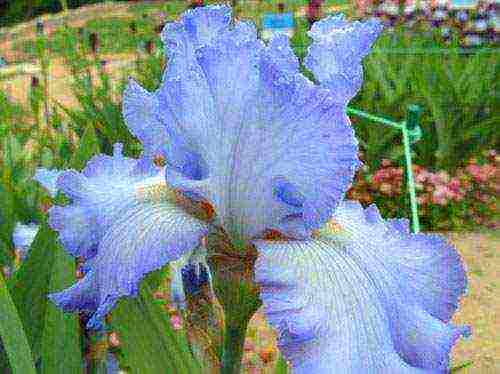
- Depeche Mode. The variety belongs to the category of flowers with a "broken color". On a delicate yellow background, a bright purple pattern appears, consisting of small strokes and thin lines.
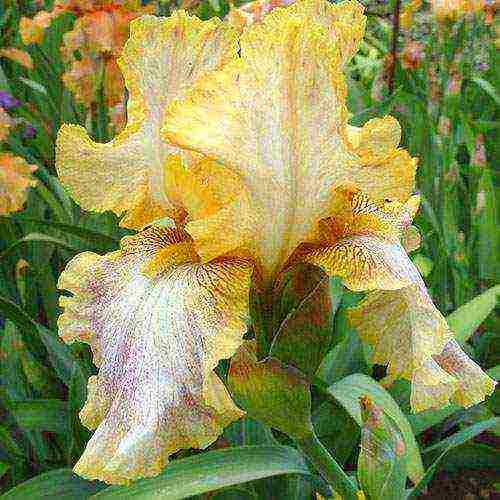
- Arabian Story. It embodies an exquisite combination of yellow and orange shades. The flowers are distinguished by a delicate aroma with notes of citrus.
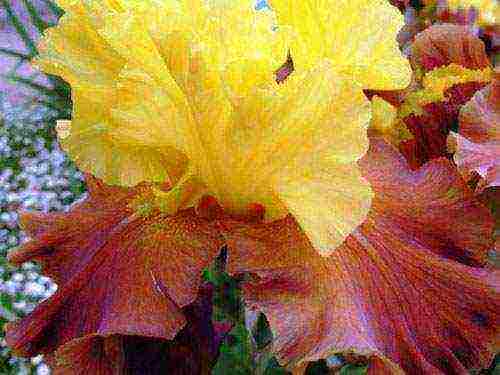
- Back in Black. Spectacular dark purple flower. From a distance, it appears almost black. Great for creating contrasting flower beds with an unusual design.
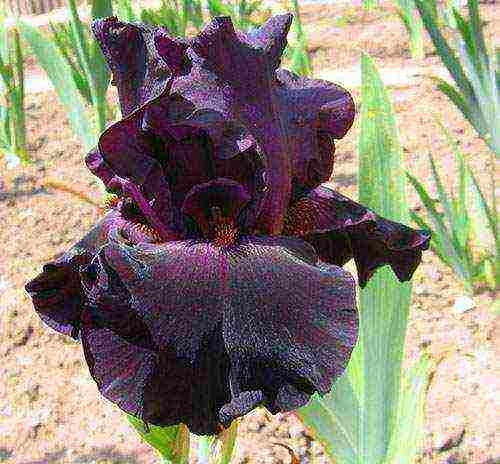
- Heritage Lace. This flower will be loved by connoisseurs of ageless classics. Like graceful lace, it creates an atmosphere of lightness and airiness.
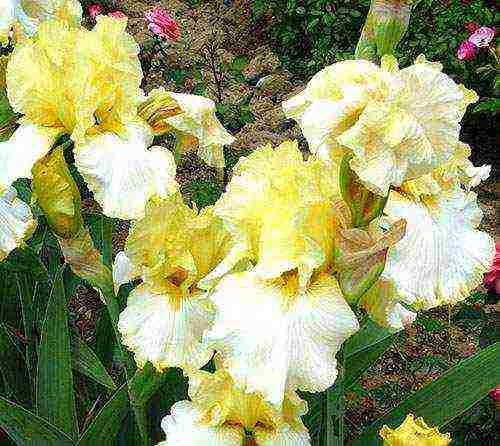
This is just a small part of all the variety on the market today. When choosing, pay attention to the fact that the flowers are in harmony with neighboring specimens and fit into the overall design of the site.
The height of such varieties can reach 80 cm, so you should not plant them in the immediate vicinity of light-loving low-growing plants.
Dwarf irises
Iris dwarf differs from its counterparts in small stature. The height of the peduncles does not exceed 40 cm. In most varieties, this parameter is even 20 cm. They will be ideal for decorating small compact flower beds. Among the most popular varieties are:
- Wink.An exquisite snow-white flower, which is framed along the edge with delicate blue petals. Two buds appear on one peduncle. The size of one flower does not exceed 9 cm.
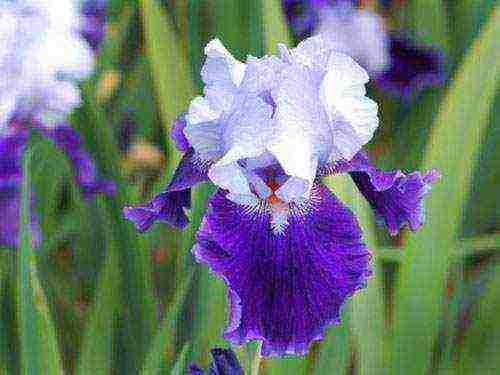
- Cry Baby. Young flowers are blue. Over time, they fade and become almost white. Up to three buds bloom on one peduncle.
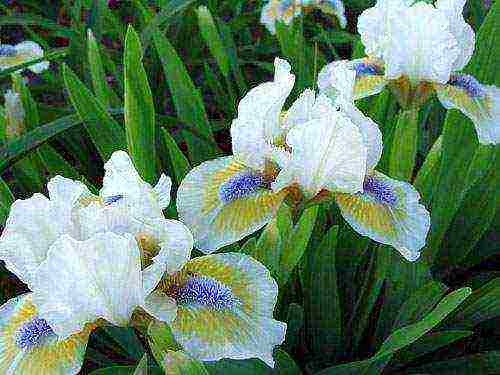
- Little Dream. The color of the petals can vary from gray to pale blue. The size of the flower does not exceed 10 cm in diameter.
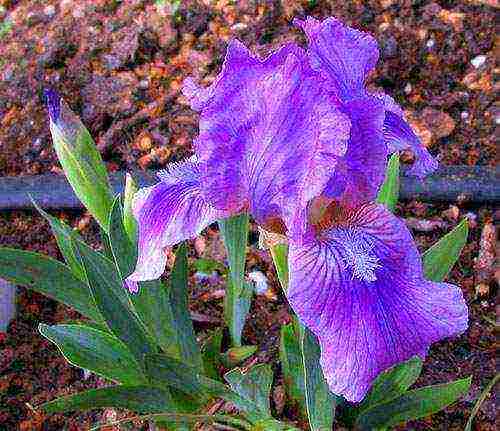
- Sapphire Gem. The petals have a bright saturated color. They show thin light grooves. The height of the stem does not exceed 37 cm. There are three or four flowers on one peduncle.
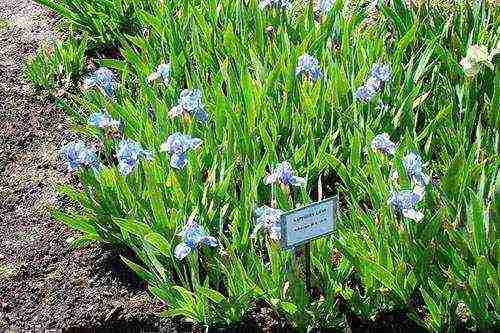
Dwarf irises thrive on light, moisture-permeable soils. If the soil in your garden is heavy, then add sand to it before planting.
Bulbous irises
Everyone is accustomed to the fact that irises are rhizome plants. Modern specialists have managed to breed several varieties that grow from bulbs. They are distinguished by their unusually early flowering. They can be compared to snowdrops. As soon as the snow melts, the first flowers appear. There are three main types:
- Iridodictum or reticulated iris. Plant height does not exceed 15 cm. In one place it can grow up to six years. Leaves appear simultaneously with the peduncle. The flowering period lasts for two weeks. Leaves and peduncles completely die off by mid-June. A distinctive feature of such flowers is a two-tone color, on which strokes of a contrasting shade are clearly visible. Popular varieties are: Dunford, Baker, Vinogradov and others.
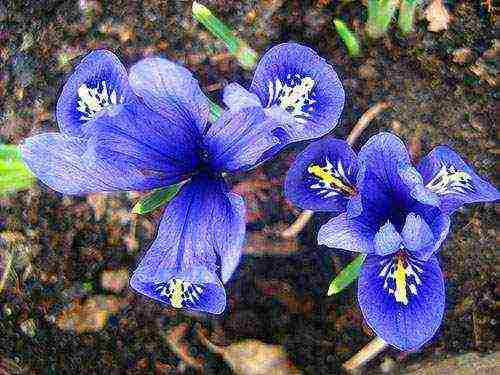
- Juno. This type of iris is considered rare. The flowering of such plants is observed in late May - early June. The height of the peduncles can reach 40 cm. The crescent-shaped leaves are arranged in several tiers. Up to five flowers can bloom on one peduncle. It is recommended to dig up the bulbs in July, dry them well and plant them back in September. Of particular interest are the varieties: Nikolai, Caucasian, Orchidnaya.

- Xyphyums or Dutch iris. This species is considered the most capricious. It will be possible to get beautiful flowers only if all the rules of agricultural technology are observed. Varieties of this species do not tolerate frost well. Therefore, the bulbs will have to be dug up for the winter. Since the price of xyphyum bulbs is low, many people prefer to grow them as an annual crop. Today on sale you can find a mix of Dutch irises. One pack of bulbs is enough to create a spectacular flower bed.
Bulbous irises look good in a flower bed with crocuses, muscari, galanthuses and so on. They are ideal for alpine slides.
These varieties can be grown in pots and large planters. They will be an excellent decoration for verandas and gazebos.
Siberian irises
Photos of Siberian irises are impressive. They are distinguished by the extraordinary beauty of flowers. The value of this species also lies in the fact that the foliage of the plant has a rich green color throughout the season. The most spectacular varieties are:
- Ester C.D.M. This iris is white with no blotches of any other colors. The flowers look light and airy. They seem to be hovering over the foliage. The variety is distinguished by large, wide leaves.

- Clarkei. The flowers are painted in delicate violet-blue tones. Small snow-white strokes stand out against their background. Peduncle height can reach 60 cm.
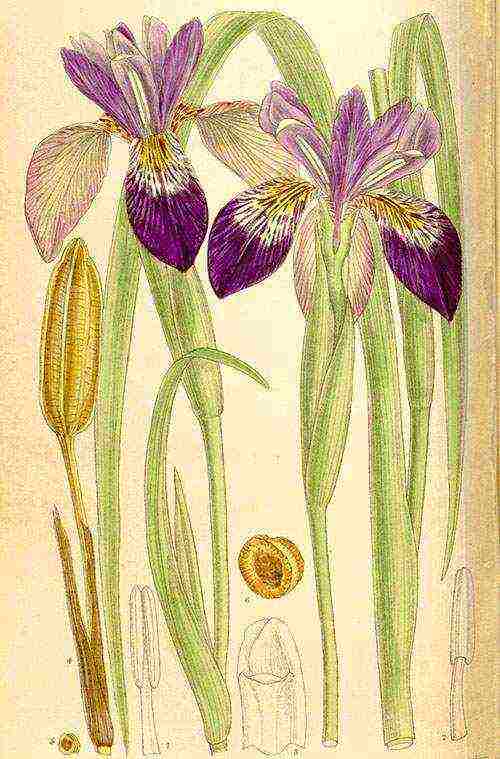
- Delavayi. This variety is distinguished by the shape of the petals. They are oblong and rather narrow. Painted in blue-violet color. Light stripes are visible on them. The peduncle does not grow more than 60 cm in height.
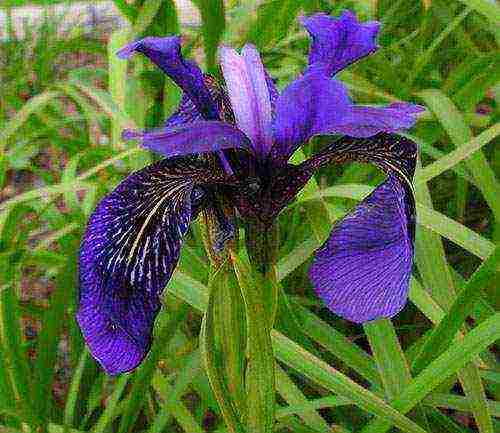
- Dykesii. Tall variety. The height of the peduncle can reach 90 cm. In the flower, dark blue petals alternate with deep purple. They have bright yellow strokes.

Such varieties look spectacular along the banks of improvised reservoirs, in large rockeries. Groups of such flowers can be used to decorate the lawn, which will make the landscape unusual.
Swamp irises
Marsh iris or iris grows everywhere in our country. The leaves of this species are xiphoid. Their length can be up to two meters. This species does well in partial shade. Therefore, such flowers can be planted along fences or near trees with a not too dense crown. Among the most popular varieties are:
- Veriegata. The flowers are medium-sized, pale blue. This iris iris is prized for its highly decorative leaves. They are bright green and have beautiful yellow stripes. The plant looks most impressive in spring. Closer to autumn, it loses its decorative effect.

- Flore Plena. This iris is yellow. Terry flowers. They stand out brightly against the dark green foliage. The plant develops well provided there is sufficient moisture and a sunny color.
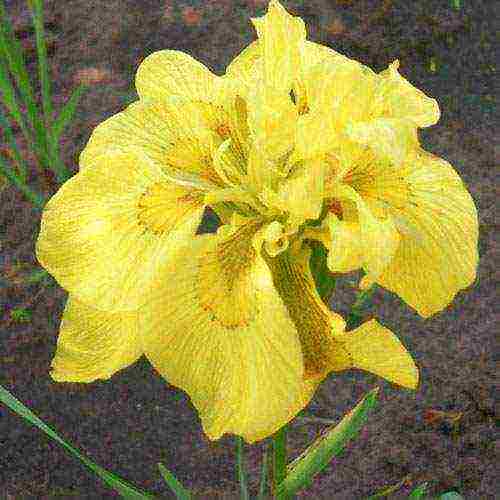
- Black Form. Spectacular dark purple flower. Small yellow strokes are visible on the lower petals. The height of an adult specimen does not exceed 50 cm.

Having studied these varieties of irises with photos and names, we can conclude that they are ideal for group plantings. With the help of different types of irises, you can create spectacular flower beds.
Japanese irises
Japanese iris has orchid flowers. Their size can vary from 15 to 25 cm. In Japan, such plants are planted so that they can be admired from a height. From this angle, they look most impressive. Plants are large, therefore, when planting between them, you must maintain a distance of at least 30 cm. The most popular varieties:
- The ghost of happiness. The flower has six petals. They are white in color and have pale pink stains. With age, the flower becomes completely white. Flowering is observed in mid-July.
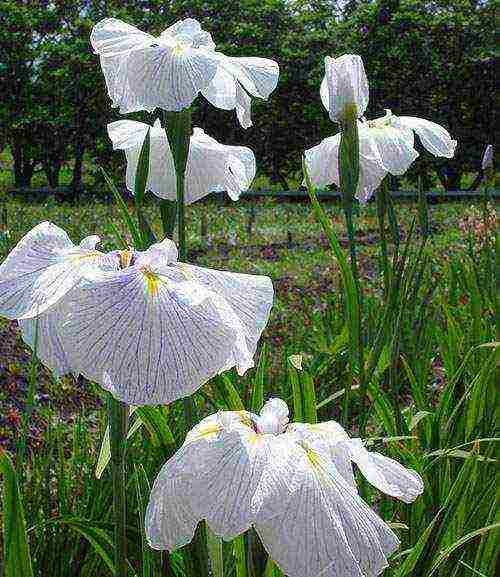
- Vasily Alferov. This is a giant plant, the height of which can reach 110 cm. It is distinguished by large dark purple flowers interspersed with yellow. The petals have a velvety texture. Flowering continues for 19 days. Three or four buds bloom on one peduncle.
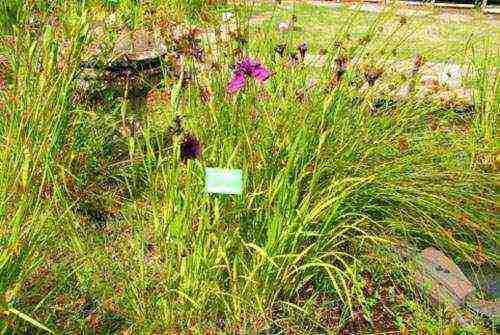
- Altai. Differs in pleasant lilac color of petals. Each flower has a small yellow tongue. Blooms for two weeks in mid-July.
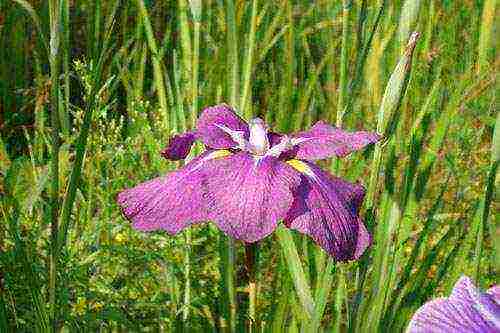
- Vivat Rodionenko. Flowers of this variety have six petals. They are painted in a delicate purple color. The petals have small bluish streaks and spots. A white pistil is visible in the middle of the flower. Two flowers bloom on one peduncle.
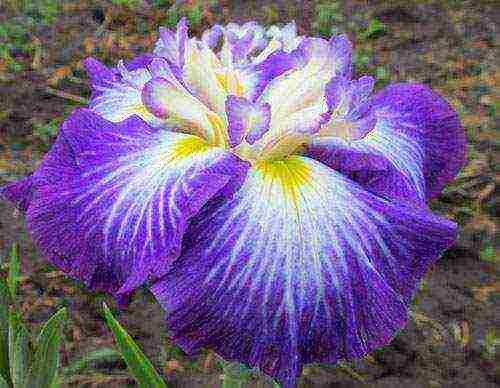
Having studied the photos of the varieties of iris varieties, you can choose the right planting material for your soil type. If you choose specimens with different flowering periods, you can admire the beauty of the flowers all summer long.
Irises bloom in the garden - video
When choosing bearded irises for growing on your site, first of all, decide on the size. The fact is that these flowers are different in their height: there are bearded irises that grow up to 70 cm, and there are those that rise no higher than 5 cm above the ground. The best varieties of bearded irises must meet certain requirements, about them you you will find out by reading this material.
Medium, tall and miniature bearded irises
Bearded irises are the most extensive group of irises, consisting of several classes.
Tall Bearded Irises (TV) - powerful plants with a height of 71 cm with a branched peduncle, many buds and large, sometimes up to 20 cm in diameter, flowers. In the suburbs, they bloom from mid-June to early July.
Medium-sized bearded irises (MB) - from 41 to 70 cm in height, are subdivided into three groups:
- border irises (BB) with a flowering period similar to a tall bearded one, but with a proportionally smaller flower;
- intermedia irises (IB) with a flower size of 10-13 cm and a flowering period in the Moscow region from the beginning of June; not necessarily highly branched, but forming a profusely flowering bush;
- dining, or miniature tall bearded irises (MTV) - high thin leafy peduncle and relatively small (no wider than 8 cm) flowers that are used mostly for the bouquet and the table, hence their name.
Standard bearded dwarfs (SDB) - height of 21-40 cm, in the suburbs bloom from the end of May.
Miniature dwarf bearded (MDB) -. The smallest height of bearded irises 5-20 cm These flowers bloom very early (in Moscow in the first half of May).
Requirements for high-bearded irises
Modern tall bearded iris - amazing flower! Anyone who saw it happen, fascinated by its beauty and extremely surprised when I learned that the luxury to grow irises did not harder than any other garden flowers or vegetables in the garden. Perhaps no one on the culture has not developed so many misconceptions that many, even very experienced gardeners treat it cautiously, usually opposing new varieties of old. And it is in vain among the modern varieties abound such that can reliably and regularly blossom in the middle lane, and even have some advantage in resistance to adversity our harsh climate, compared with historical varieties. Therefore, of course, should strive to acquire new varieties. But the main advantage of new varieties that are incomparably more beautiful than the old ones.
Progress color selection of high bearded irises striking. The main focus is on the flower, because even just one flower - whether it grows in a garden or stands in a vase - is able to conquer the gardener's imagination and fall in love with itself forever. Until now, there are new color combinations, exquisite color patterns, immediately conquering the huge popularity. But, despite all the advances in expanding the range of colors of irises, the focus is on the quality of the flower.
By the quality of the flower means:
- broad, sometimes ganging up in the grounds of halyards and serried banners, flower delayushie assembled, round and expressive;
- density texture of petals, which provides weather resistance and longer life of the flower;
- grace and uniformity of the corrugation of the shares;
- width, density and expression of barbs.
EXAMPLE excellent quality flower - Class 'Paris Fashion' China Keppel. Giant flowers are required and proportional to their size stalks - tall, strong, resistant to wind gusts. To drop the flowers do not interfere with each other, they must be "separated" for quite long branches, and to provide a longer duration of flowering in the inflorescence should be a large number of buds.
A special attraction are the so-called exhibition varieties, at the same time disclosed having 3-5 flowers per spike.
It paid a lot of attention and attraction iris garden - foliage health, fast razrastaemosti bush and representativeness of its flowering, when the best is the number of inflorescences on the bush, approximately equal to half the number of fans of the leaves.
Of particular interest are such varieties, shrubs which flower stalks are not at the same time throw, and over a period of time, providing an exceptionally long flowering. Duration of flowering have remontant varieties.
With proper selection of varieties of tall bearded irises bloom stretched to 50 days.
The main requirement is that the iris varieties for growing in northern regions - the energy of growth, it allows you to compensate for the shortcomings of many other plants. The next most important quality - frost. The ability to withstand low temperatures in winter is related to the rhythm of plant development. Irises, which by the end of the summer growth ends and the leaves die off, hibernate is much better and, consequently, their flower buds are not damaged in the harsh winters.
Tall bearded iris - rather thermophilic.So, in the Moscow region and to the north, only 20% of varieties of their total number are successfully growing. Therefore, my advice to amateur gardeners is to be interested in its frost resistance when buying.
Resistance to fungal and bacterial diseases is another important quality. Resistance to bacteriosis and heterosporiosis ensures healthy foliage, decorative planting and regularity of flowering.
The standard planting unit for bearded irises is usually a one-year iris rhizome growth. In the middle lane, they reach acceptable sizes by the beginning of August. This is the reason for the recommended planting time - the first half of August, however, good results can be obtained when planting before the beginning of September.
Which rhizomes are better for planting: large or small, annual (short) or biennial (long)? The answer to this question depends on your goals: if you, by all means, want to see an iris flower the next year after planting, choose a large rhizome with a wide fan of 6-8 leaves. If flowering for the next year is not important for you, and the reliability of overwintering and plant survival are of paramount importance, choose a medium-sized one-two-year rhizome with a diameter of 2-2.5 cm, with 3-4 leaves.
Agricultural technology for growing bearded irises: planting and care
The agricultural technique of growing bearded irises depends on the purpose of their cultivation, so it is impossible to give any universal scheme. Some grow irises, planting and annually digging planting material, usually for sale. Others plant irises to decorate the garden in a curb, mixborder, rockery or on a rocky hill, where it is advisable not to touch them for several years.
Lighting and drainage are the most important factors in successful growing. Also remember that irises are heat-loving plants. The more sun the irises receive in the garden, the better they bloom. A little shade in the morning or evening is, of course, acceptable, but only a few varieties of irises, such as the 'In a Flash' intermedia, will withstand a more serious shade. The southern slopes are preferable to the northern ones; a place near the southern wall of the building will also be good. It is good if the landing site is cleared from the prevailing cold winds.
With excessive soil moisture, the respiration of the roots is disturbed, and they partially die off, this leads to a slowdown in the development of plants.
In such conditions, bacterial rot also develops on the rhizomes of irises.
If the soil is sufficiently drained, irises can be planted on a flat surface, if the soil is heavy, clayey, then it is better to plant them on a hill or on ridges. The ridges are also more convenient from the point of view of arranging a winter shelter.
High soil fertility is the key to successful cultivation and productivity of tall bearded irises in central Russia.
Bearded irises work best on light sandy soils. Loam is also acceptable, but the addition of sand and organic materials (peat, composted sawdust, humus) significantly improves the structure and permeability of the soil, which leads to excellent results. It is only necessary to take into account that in order to improve the soil to a depth of 20 cm, it will be necessary to add about 100 liters of sand per 1 m2 of soil.
The optimum level of reaction of the soil medium (pH) is 6.8.
If you intend to grow irises on ridges, then their preparation consists of the following operations:
- freeing the site from the roots of perennial weeds;
- delivery of compost or other available organic material to the site;
- leveling organic matter on the site with the simultaneous introduction of wood ash or dolomite flour and mixing them with the soil with a pitchfork or a shovel.
- introduction of mineral fertilizers under a rake: potassium sulfate and superphosphate, as well as ground or colloidal sulfur in an amount of 5-7 g / m2;
- shaping the profile of the ridge and compaction of the soil to avoid its further subsidence and bulging of newly planted plants. The height of the ridge profile after compaction is approximately 7-8 cm;
- delivery of coarse-grained river or washed quarry sand to the ridges in such an amount to form a layer of about 5-7 cm, and its leveling;
- the ridge is ready for planting. To preserve the structure of the ridge, it is convenient to plant the bearded irises as follows: slightly push the sand apart by sticking a spade bayonet into it, place the roots of the iris cut into the gap, compact the soil around the roots and water the substrate to the planted iris cut so that it is in the layer sand.
Delenki are planted on the ridge in such a way that the trimmed part of the rhizome is directed to the edge of the ridge, and the fan of leaves is towards the middle. In this case, the growing roots will be directed towards the center of the ridge, which will facilitate further watering of the plants in the groove in the center of the ridge.
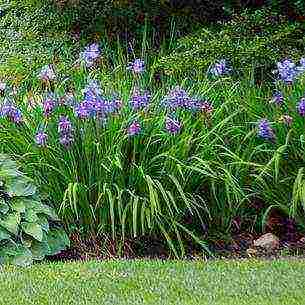
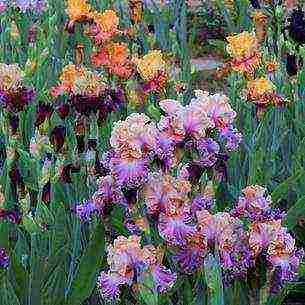
Irises can be replanted at any time during the growing season. However, replanting in spring can result in poor flowering this year. In the middle lane, optimal results are obtained when planting and transplanting irises in August: the plants have enough time for rooting and gaining sufficient mass to fully bloom next year. Irises planted later, that is, in the fall, usually remain healthy, but do not have time to take root before the onset of cold weather. This can lead to bulging of rhizomes from the ground when the soil freezes. To avoid protruding rhizomes, additional mulching for the winter is required, or simply fixing the rhizome with a suitable improvised object.
Irises love space, usually the recommended distance between plants is 30-50 cm. Delenk of the same variety can be planted closer, however, it is necessary to ensure that the fans of their leaves are directed in opposite directions.
When replanting an old bush, do not try to preserve all the shoots. Planting two or three large fans will give better results than 5-10 small ones.
A common mistake when planting and caring for bearded irises is over-deepening the rhizome. It is recommended to plant irises so that the back of the rhizome is at the surface of the soil. For the winter, it is better to sprinkle the open rhizome with soil, and in the spring it needs to be shaken off.
When caring for bearded irises, watering is required in the first weeks after planting irises for successful rooting. For adult specimens of bearded irises, watering is necessary for abundant flowering only when there is a lack of rainfall, especially in May, when there is often hot dry weather, sometimes in June-July. However, in August and even more so in September-October, adult bushes no longer need watering. At this time, the plant is preparing for winter, and its growth should not be stimulated.
Top dressing for irises should be given both in early spring and 3-4 weeks after flowering. A quick effect is given by top dressing with soluble fertilizers: in spring - complex with microelements, in July-August - with potassium phosphate.
For the successful cultivation of bearded irises, phosphorus is the most important from the main nutrients, so it is advisable to fill the soil with superphosphate (100 g / m2) or bone meal (200-300 g / m2) when preparing a plot for irises. For spring-summer dressings, you can use a complex fertilizer with a low nitrogen content, for example, NPK = 6: 10: 10. The autumn mixture has a NPK ratio of 0: 13: 18, it also contains magnesium and elemental sulfur, the latter being 5%. The spring feeding mixture has the formula NPK = 8: 37: 11.
The best organic fertilizer for irises is well-rotted compost.
Bearded irises successfully grow in one place for 4-5 years. The specific timing of the renewal of the bush depends on both the variety and the agricultural technology used. Some time after planting, the iris bush thickens, which ultimately leads to the cessation of flowering. How quickly thickening occurs depends on the multiplication factor of the variety. Some varieties are also characterized by vigorous growth, and at the same time they are not too demanding on external conditions.
With the age of the bush, it is desirable to increase the amount of dressings.If these measures do not bring the desired effect, the bush must be dug out entirely, the soil must be renewed by adding ripe compost and phosphorus-potassium fertilizers, and the 3-4 strongest shoots must be planted, shortening the leaves by about 2/3.
Many modern varieties do not need shelter for the winter. If the variety is chosen for the beauty of the flower, but is not winter-hardy enough, additional efforts will be required in preparation for winter. The main problems for irises in winter in the middle lane arise when an ice crust forms on the frozen ground without snow, which prevents the respiration of plants.
It is convenient to cover irises with spruce branches or oak leaves, which tend not to cake. To prevent such a frame from getting wet, it must be covered with a non-woven covering material or a film - under them the irises will not adhere in winter.
Irises winter best under a dry air shelter with preliminary drying of the ridge, which is usually enough for one month. The easiest way to protect from rain is with a dense reinforced film laid on arcs or directly on the iris foliage. At the same time, the ends of the shelter should be open for free air circulation, and they must be closed for the winter. The tentative time for the construction of the shelter is the end of October - the beginning of November.
In the spring, the film is removed from the shelter as early as possible, immediately after the snow melts, and other material - as needed.
Varietal irises are propagated vegetatively, that is, by dividing the rhizomes. For accelerated reproduction, you need to remove the flower bud located at the base of the fan of leaves in the fall. After that, the lateral buds of the plant begin to grow, which in the spring form new powerful shoots. You do not need to dig out the rhizome to separate them. On a dry, sunny day, you need to shake off the ground, cut off the dried and yellowing leaves, and cut the remaining green leaves to the rhizome. The cut must be disinfected and left to dry in the sun. After a few days the wound is healed, the rhizome must be mulched with soil so that roots can form in the awakening buds. The division of the rhizome into kidney cuttings, which is often recommended for the propagation of irises, is a much less effective method, since in this case the plant is severely injured and, as a result, flowering occurs much later.
For reproduction, dormant buds on 2-3-year-old links of rhizomes can be successfully used. To do this, pieces of rhizomes are cut out from the middle of the bush and simply transplanted to a new place.
New varieties of tall bearded irises for the middle lane
The following are photos, names and descriptions of new varieties of tall bearded irises for the middle lane, recognized by gardeners as the best for growing on the site.
The description contains the following data: name of the bearded iris variety, originator, year of registration, characteristic of the flower, flowering period.
Sundress
Pirogov 2000
The top is golden smoky with a lilac bloom. Purple dots and strokes, golden smoky border along the white field of the bottom. Bright yellow pistil ridges glowing in the depths of the flower. Exceptionally vigorous growth and regular, profuse and long flowering. Early.
Queen
Sholupov 2003
Intense purplish violet with velvety texture and powerful crinkle. An exhibition peduncle easily holds several open flowers at the same time. Average flowering time.
Cranberry Sauce
Black 2002
Cranberry South
Silky-shiny flower with lilac-crimson overflow. The yellow beards accentuate the great depth of color. Average flowering time.
Darcy's Choice
Schreiner 2007
Aarsis Chois flower of original color with white beards on crimson halyards. Wonderful branched peduncle. Average flowering time.
Dawn To Dusk
Schreiner 2008
Aone To Dask
A two-colored pink-purple flower that takes on a unique gray tint on acidic soils: unexpected and attractive. Medium late.
Edgefield glow
Schreiner 2011
Edgefield Glow
Orange flower of exceptional brightness with dark tangerine beards.This new variety of bearded irises has an incomparable color and excellent vigor not found in other orange forms. Medium early.
Never been kissed
Blyth 2008
Never Win
Kissed Fashionable reverse: blue top and pure white bottom. Luxurious flower of delicate color. A distinctive feature is the best corrugation to date. Medium early.
Palace symphony
Blyth 2007
Palace Symphonies
A purple-wine flower with almost black beards and exceptional corrugation. A variety that combines the best features of American and Australian breeding. Average flowering time.
Royal birth
Royal 2003
Royal Burf
Creamy white with golden halyard bases. Dense flower texture. Abundant flowering and steady growth. Medium early flowering period.
Undivided Attention
Ernst 2004
Antiwaged Attension
Deep pink, warm salmon color, denser in the center of the flower. Bright coral beards. Abundantly flowering cultivar. Medium late.
Warranty
T. Johnson 2004
Warranty
A huge hovering purple-black flower with a velvety texture on a tall peduncle. Medium late flowering period.

